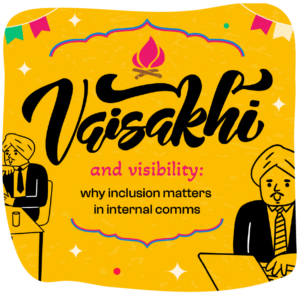Vaisakhi, a major festival for the Sikh community and in parts of Hindu culture, is a moment of celebration, reflection and identity. But in many organisations, cultural events like this pass quietly – if they’re acknowledged at all.
For internal comms teams, that’s a missed opportunity. Not just to mark a cultural moment, but to demonstrate what great communication really does: connect, include, and make people feel seen.
Here’s why acknowledging moments like Vaisakhi matters and how internal comms can lead the way.
 Inclusion builds belonging and belonging builds trust
Inclusion builds belonging and belonging builds trust
People do their best work when they feel like they belong. But belonging doesn’t happen by accident. It comes from feeling seen, heard, and valued. Not just for what you do, but for who you are.
Recognising events like Vaisakhi shows that your organisation doesn’t just tolerate difference but respects and celebrates it. That sends a powerful message to Sikh employees, and to everyone else: this is a place where all identities matter.
Culture is shaped by what (and who) you talk about
Internal comms shapes organisational culture. What you spotlight tells people what’s important. So, when you actively highlight cultural celebrations, you help widen the lens of what’s “normal” at work.
Acknowledging Vaisakhi isn’t just for Sikh colleagues – it also helps others learn, connect and grow. It challenges assumptions, builds empathy, and broadens the workplace culture for everyone.
Vaisakhi is one of many moments that matter
Vaisakhi is just one of many cultural and religious festivals celebrated by people of colour across the UK. Others include:
- Ramadan & Eid – observed by Muslim colleagues, often involving fasting and reflection
- Diwali – the Hindu festival of lights
- Hanukkah – a Jewish celebration of resilience and light
- Kwanzaa – honouring African heritage and community
- Lunar New Year, Navratri, Nowruz, Rosh Hashanah, Holi, and many more
According to the
2021 census, together these religions represent approximately 24% of the UK population’s beliefs.
Each of these carries deep personal meaning for the people who observe them. And while they may not all be widely celebrated in your office, that’s exactly why it’s so important to acknowledge them.
The harm of silence
It’s easy to think that not saying anything is neutral. But silence can send a message too…and not always the right one.
Take Ramadan, for example. If internal comms doesn’t acknowledge it, teams may plan social events like lunch-and-learns or after-work drinks that unintentionally exclude those who are fasting. It’s not just awkward – it can feel deeply isolating.
The same applies to other key moments. If something is making a big impact on someone’s personal or spiritual life, and work carries on like it doesn’t exist, it can feel like they don’t exist either.
And that’s the opposite of what internal comms is here to do.
Even small gestures have a big impact
You might only have one Sikh team member. Or none that you know of. But acknowledging Vaisakhi, even with something as simple as a message on your intranet, a Slack post, or a short email, can go a long way.
These moments don’t need to be turned into full-blown campaigns. But when done with care and intention, they show your team that your culture isn’t one-size-fits-all but that it’s built for everyone.
Engagement starts with representation
People are more likely to engage when they see themselves reflected in your comms. That’s true for your visuals, your voices, your storytelling, and your recognition of what matters to your people.
So, ask yourself:
- Do your internal campaigns reflect the diversity of your workforce?
- Do people see their lives, values and cultures represented?
- Are you giving people a chance to contribute to the stories you tell?
When you engage with cultural moments like Vaisakhi, you signal that every voice matters. And that opens the door to deeper engagement across the board.
Inclusion strengthens comms channels
When you consistently include and represent a wide range of employees, you strengthen the credibility of your internal comms. People trust channels that reflect them, and they’re more likely to pay attention, contribute, and engage when they feel seen.
These aren’t just feel-good gestures. They’re smart, strategic communication choices.
It’s not about ticking boxes, it’s about being human
True inclusion isn’t performative. It’s not about posting a message and moving on. It’s about creating space: space for stories, perspectives, and celebrations that reflect the full spectrum of your workforce.
So, when Vaisakhi (April 14th), or any cultural celebration, comes around, don’t just say “Happy Vaisakhi.”
Ask:
- Who in our organisation celebrates this?
- What does it mean to them?
- How can we amplify their voices, not just observe the date?
Inclusion is a conversation, not a campaign.
Final reflections
When internal comms leads with inclusion, everyone benefits. People feel seen, cultures are respected, and the workplace becomes a more human, connected place.
Vaisakhi is just one example, but it’s a reminder that every celebration we recognise is a chance to build a better culture.
Because when you include everyone, you engage everyone.
Thinking about taking inclusivity in your internal comms to the next level but not sure where to start? Drop us an email – we’d love to chat.
 Inclusion builds belonging and belonging builds trust
Inclusion builds belonging and belonging builds trust















